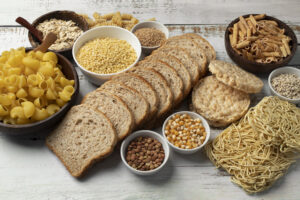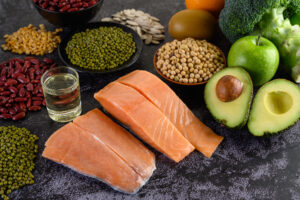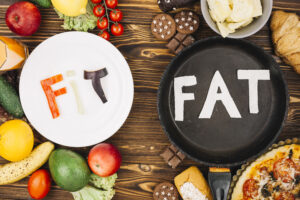Macronutrients are fundamental parts of our eating regimen, giving the energy and supplements important for development, digestion, and by and large wellbeing. The three essential macronutrients are sugars, proteins, and fats, each assuming a pivotal part in basicphysical processes. Carbs, as one of the macronutrients, act as the body’s principal energy source, while proteins, another key macronutrient, are indispensable for tissue fix and muscle development. Fats, the third macronutrient, are significant for cell structure, chemical creation, and supplement assimilation.
A decent admission of these macronutrients guarantees that the body works ideally, featuring the significance of understanding and overseeing macronutrient utilization in our day to day slims down. Guaranteeing that our feasts contain a fitting blend of these macronutrients is basic to keeping up with great wellbeing and forestalling nourishing inadequacies.
Carbohydrates
Carbohydrates, Proteins, and Fats are the primary kinds of macronutrients in food (supplements that are required day to day in huge amounts). They supply 90% of the dry load of the eating regimen and 100 percent of its energy. Each of the three give energy (estimated in calories), however how much energy in 1 gram (1/28 ounce) contrasts:
- 4 calories in a gram of carbs or proteins
- 9 calories in a gram of fats
These supplements additionally contrast in how rapidly they supply energy. Starches are the fastest, and fats are the slowest.Macronutrients are processed in the digestive system, where they are separated into their fundamental units:
- Starches into sugars
- Proteins into amino acids
- Fats into unsaturated fats and glycerol
- The body utilizes these fundamental units to fabricate substances it needs for development, support, and movement (counting different sugars, proteins, and fats).

Outline of Carbohydrates
Refined carbs:
Different types of sugar, like fructose (organic product sugar) and sucrose (table sugar), are straightforward starches. They are little atoms, so they can be separated and consumed by the body rapidly and are the fastest wellspring of energy. They rapidly increment the degree of blood glucose (glucose), which is likewise a straightforward sugar. Organic products, dairy items, honey, and maple syrup contain a lot of straightforward starches, which give the sweet desire for most confections and cakes.
Complex carbs:
These starches are made out of lengthy strings of basic carbs. Since complex carbs are bigger atoms than basic carbs, they should be separated into straightforward starches before they can be ingested. Consequently, they will quite often give energy to the body more leisurely than basic starches yet at the same time more rapidly than protein or fat. Since they are processed more leisurely than straightforward sugars, they are less inclined to be changed over completely to fat. They likewise increment glucose levels more leisurely and to bring down levels than basic sugars however for a more extended time frame. Complex carbs incorporate starches and strands (which happen in wheat items like breads and pastas), different grains (like rye and corn), beans, and root vegetables (like potatoes and yams).
Refined implies that the food is profoundly handled. The fiber and wheat, as well as a significant number of the nutrients and minerals they contain, have been stripped away. Hence, the body processes these carbs rapidly, and they give little nourishment in spite of the fact that they contain about similar number of calories. Refined items are in many cases advanced, meaning nutrients and minerals have been added back to build their dietary benefit. An eating regimen high in basic or refined carbs will in general build the gamble of weight and diabetes.
On the off chance that individuals consume a larger number of sugars than they need at that point, the body stores a portion of these carbs inside cells (as glycogen) and converts the rest to fat. Glycogen is a perplexing carb that the body can without much of a stretch and quickly convert to energy. Glycogen is put away in the liver and the muscles. Muscles use glycogen for energy during times of extraordinary activity. How much starches put away as glycogen can give very nearly a day of calories. A couple of other body tissues store sugars as perplexing starches that can’t be utilized to give energy.
Most specialists prescribe that around 50 to 55% of all out day to day calories ought to comprise of carbs, generally coming from natural products, vegetables. beans and vegetables, and raw grains. Less than 10% of all out day to day calories ought to come from added sugars. Added sugars are syrups and other caloric sugars utilized in other food items. Added sugars are recorded as a fixing in food names. They incorporate earthy colored sugar, corn sugar, corn syrup, dextrose, fructose, glucose, high-fructose corn syrup, honey, alter sugar, lactose, malt syrup, maltose, molasses, crude sugar, sucrose, trehalose, and turbinado sugar. Normally happening sugars, like those in natural product or milk, are not added sugars.
Glycemic Index
The glycemic Index is an approach to characterizing food in light of how rapidly utilization of its starches increments glucose levels. Values range from 1 (the slowest) to 100 (the quickest, the list of unadulterated glucose). In any case, how rapidly the level really increments likewise relies upon what different food sources are ingested simultaneously and different elements.
The glycemic file will in general be lower for complex carbs than for basic sugars, yet there are special cases. For instance, fructose (the basic starch sugar in organic products) has a low glycemic file.
The accompanying likewise impact a food’s glycemic file:
- Handling: Handled, refined, or finely ground food varieties will more often than not have a higher glycemic file.
- Sort of starch: Various kinds of starch are consumed in an unexpected way. For instance, potato starch is processed and retained into the circulation system generally rapidly. Starch in grain is processed and retained substantially more leisurely.
- Fiber content: The more fiber a food has, the harder it is to process. Accordingly, sugar is ingested all the more leisurely into the circulatory system.
- Readiness of natural product: The riper the organic product, the more sugar it contains, and the higher its glycemic file.
- Fat or corrosive substance: The more fat or corrosive a food contains, the more leisurely it is processed and the more leisurely its sugars are retained into the circulatory system.
- Readiness: How a food is arranged can impact how rapidly it is consumed into the circulation system. For the most part, preparing or crushing a food builds its glycemic list in light of the fact that these cycles make food simpler to process and retain.
- Different variables: The manner in which the body processes food shifts from one individual to another, influencing how rapidly starches are switched over completely to sugar and assimilated. How well a food is bitten and how rapidly it is gulped likewise make a difference.
- The glycemic record is believed to be significant in light of the fact that starches that increment glucose levels rapidly (those with a high glycemic file) likewise rapidly increment insulin levels. The expansion in insulin might bring about low glucose levels (hypoglycemia) and yearning, which will in general prompt consuming abundance calories and putting on weight. In any case, diet specialists never again feel that eating food varieties with a low glycemic record assists individuals with getting more fit.
- Carbs with a low glycemic record don’t increment insulin levels to such an extent. Therefore, individuals feel satisfied longer in the wake of eating. Consuming carbs with a low glycemic record likewise will in general bring about more fortifying cholesterol levels and lessens the gamble of heftiness and diabetes mellitus and, in individuals with diabetes, the gamble of difficulties because of diabetes.
Regardless of the relationship between food sources with a low glycemic record and further developed wellbeing, utilizing the file to pick food varieties doesn’t consequently prompt a solid eating routine. For instance, the glycemic file of potato chips and some treats — not energizing decisions — is lower than that of a few stimulating food sources, like earthy colored rice. A few food varieties with a high glycemic file contain important nutrients and minerals. Subsequently, this record ought to be utilized exclusively as a general manual for food decisions.
Glycemic load
The glycemic Load demonstrates just how rapidly sugars in a food are retained into the circulation system. It doesn’t consider how much sugar a food contains, which is likewise significant. Glycemic load incorporates the glycemic file and how much starch in a food. A food, like carrots, bananas, watermelon, or entire wheat bread, may have a high glycemic file yet contain somewhat little carb and consequently have a low glycemic load. Such food varieties affect the glucose level.
Glycemic load likewise incorporates what changes in glucose are meant for by the mix of food sources eaten together. The glycemic file doesn’t.

Proteins
Proteins comprise of units called amino acids, hung together in complex developments. Since proteins are mind boggling atoms, the body takes more time to separate them. Subsequently, they are a lot increasingly slow enduring wellspring of energy than sugars.
Outline of Proteins
There are 20 amino acids. The body blends some of them from parts inside the body, yet it can’t incorporate 9 of the amino acids — called fundamental amino acids. They should be consumed in the eating routine. Everybody needs 8 of these amino acids: isoleucine, leucine, lysine, methionine, phenylalanine, threonine, tryptophan, and valine. Babies likewise need a ninth one, histidine. The level of protein the body can use to orchestrate fundamental amino acids shifts from one protein to another. The body can utilize 100 percent of the protein in egg and a high level of the proteins in milk and meats. The body can utilize somewhat less than half of the protein in many vegetables and oats.
The body needs protein to keep up with and supplant tissues and to work and develop. Protein isn’t generally utilized for energy. Nonetheless, in the event that the body isn’t getting an adequate number of calories from different supplements or from the fat put away in the body, protein is separated into ketone bodies to be utilized for energy. On the off chance that more protein is consumed than is required, the body separates the protein and stores its parts as fat. The body contains a lot of protein. Protein, the principal building block in the body, is the essential part of most cells. For instance, muscle, connective tissues, and skin are completely worked of protein.
Grown-ups need to eat around 60 grams of protein each day (0.8 grams per kilogram of weight or 10 to 15% of all out calories). Whether consuming more aides most grown-ups is questionable. Grown-ups who are attempting to fabricate muscle need more. Youngsters additionally need more protein since they are developing. Individuals who are pregnant or lactating or who have basic disease additionally need more. Individuals who are restricting calories to shed pounds commonly need a higher measure of protein to forestall loss of muscle while they are getting thinner. More seasoned individuals might require more elevated levels of protein up to 1.2 g/kg body weight. Notwithstanding, this sum is unreasonable and possibly unsafe in specific circumstances like renal deficiency and kidney disappointment. Concentrates likewise show that protein is seriously satisfying (assists individuals with feeling full longer) than sugars and fats.

Fats
Fats are mind boggling atoms made out of unsaturated fats and glycerol. The body needs fats for development and energy. It additionally utilizes them to orchestrate chemicals and numerous different substances required for the body’s exercises (like prostaglandins).
Outline of Fats
Fats are the slowest wellspring of energy yet the most energy-effective type of food. Every gram of fat supplies the body with around 9 calories, over two times that provided by proteins or sugars. Since fats are a particularly proficient type of energy, the body stores any overabundance energy as fat. The body stores overabundance fat in the mid-region (instinctive fat) and under the skin (subcutaneous fat) to utilize when it needs more energy. The body may likewise store overabundance fat in veins and inside organs, where it can hinder blood stream and harm organs, frequently causing serious problems.
Unsaturated fats
At the point when the body needs unsaturated fats, it can make (blend) certain ones. Others, called fundamental unsaturated fats, can’t be blended and should be consumed in the eating routine. The fundamental unsaturated fats make up around 7% of the fat consumed in a typical eating regimen and around 3% of all out calories (around 8 grams). They incorporate linoleic corrosive and linolenic corrosive, which are available in specific vegetable oils. Eicosapentaenoic corrosive and docosahexaenoic corrosive, which are unsaturated fats fundamental for mental health, can be incorporated from linolenic corrosive. Be that as it may, they likewise are available in specific marine fish oils, which are a more proficient source.
Linoleic corrosive and arachidonic corrosive are omega-6 unsaturated fats. Alpha-linolenic corrosive, eicosapentaenoic corrosive, and docosahexaenoic corrosive are omega-3 unsaturated fats. An eating routine wealthy in omega-3 unsaturated fats might decrease the gamble of atherosclerosis (counting coronary corridor sickness). Lake trout and certain remote ocean fish contain a lot of omega-3 unsaturated fats. (Ladies who are pregnant or breastfeeding ought to pick fish that are low in mercury. See Mercury in Fish for more data.) In the US, individuals will quite often devour sufficient omega-6 unsaturated fats, which happen in the oils utilized in many handled food sources, however insufficient omega-3 unsaturated fats. The suggested admissions of fundamental unsaturated fats can be met with 2 to 3 tablespoons of vegetable fat everyday or by consuming a 3.5-ounce part of greasy fish like salmon two times per week.
Types Of Fats
There are various types of fat:
- Monounsaturated
- Polyunsaturated
- Saturated Fats
Saturated Fats
Saturated fats are bound to increment cholesterol levels and increment the gamble of atherosclerosis. Food sources got from creatures regularly contain soaked fats, which will quite often be strong at room temperature. Fats got from plants usually contain monounsaturated or polyunsaturated unsaturated fats, which will more often than not be fluid at room temperature. Palm and coconut oil are special cases. They contain more soaked fats than other plant oils.
Trans-Fats
Trans fats (trans unsaturated fats) are an alternate class of fat. They are man-made, shaped by adding hydrogen iotas (hydrogenation) to monounsaturated or polyunsaturated unsaturated fats. Fats might be to some extent or completely hydrogenated (or immersed with hydrogen particles). In the US, the really dietary wellspring of trans fats is to some degree hydrogenated vegetable oils, recently utilized in many financially pre-arranged food varieties. Consuming trans fats may antagonistically influence cholesterol levels in the body and may add to the gamble of atherosclerosis. Along these lines, the US Food and Medication Organization (FDA) has restricted the utilization of trans fats in pre-arranged food varieties.
Fat in Diet ( Recommendations)
- Fat ought to be restricted to not exactly around 28% of day to day all out calories (or less than 90 grams each day).
- Soaked fats ought to be restricted to under 8%.
- Killing trans fats from the eating routine is suggested. Whenever the situation allows, monounsaturated fats and polyunsaturated fats, including omega-3 fats, ought to be fill in for soaked fats and trans fats.
- Individuals with elevated cholesterol levels might have to lessen their absolute fat admission much more.


Very informative